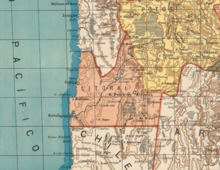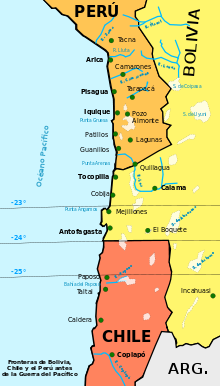Litoral Department
| Department of the Litoral Departamento del Litoral | |||||||||
|---|---|---|---|---|---|---|---|---|---|
| Department of Bolivia | |||||||||
| 1825–1904 | |||||||||
|
Flag | |||||||||
 The Litoral Department in 1894[a] | |||||||||
| Capital | La Mar (1867–1875) Antofagasta (1875–1879) | ||||||||
| Demonym | Litorense | ||||||||
| Area | |||||||||
• 1879 | 154,393 km2 (59,611 sq mi) | ||||||||
| Population | |||||||||
• 1879 | 15,000 | ||||||||
| Historical era | 19th Century | ||||||||
• Created as Atacama Department | 29 January 1825 | ||||||||
• Reorganized as the Litoral Province | 1 July 1829 | ||||||||
• Reorganized as the Litoral District | c. 26 October 1839[1] | ||||||||
• Reorganized as the Litoral Department | 2 January 1867 | ||||||||
| 14 February 1879 | |||||||||
• War of the Pacific begins | 5 April 1879 | ||||||||
| 4 April 1884 | |||||||||
• Antofagasta Province created by Chile | September 1888 | ||||||||
| 20 October 1904 | |||||||||
| |||||||||
| Today part of | Chile | ||||||||
The Department of the Litoral, also known as the Atacama Department[2] and commonly known as the Bolivian coast, was the description of the extent of the Pacific coast of the Atacama Desert included in the territory of Bolivia from its inception in 1825 until 1879, when it was lost to Chile.
Background
[edit]
When Bolivia emerged in 1825 as an independent state, these territories were part of the Bolivian Potosí Department. During the government of Andrés de Santa Cruz, the territories were established as the Department of the Litoral.
The main towns on the Pacific coast, from north to south, were Tocopilla, Cobija, Mejillones and Antofagasta.
The port of Paposo was taken from the colony as the capital of the coast Atacameño. After it consolidated its independence, Chile executed various acts of sovereignty on the northern desert coast. It established its territory throughout the coast to the mouth of the River Loa, forming a border with Peru. Chile would have expanded more, but this was prevented by Bolivia establishing the city of Cobija.
Administrative divisions
[edit]In 1875 the capital of the department was moved from La Mar (today Cobija) to Antofagasta.[3][4] When the War of the Pacific broke out in 1879, the divisions of the department were as follows:
| Provinces | Capital |
|---|---|
| Mejillones | Antofagasta |
| Cobija | La Mar |
| Loa | Tocopilla |
| Caracoles | Caracoles |
| Atacama | San Pedro de Atacama |
Treaties
[edit]
The treaty of 1866 established the border between the two States on the parallel 24°, creating an area of common interests between 23 and 25 degrees south latitude.[clarification needed]
The treaty of 1874, which established the final boundary between the two nations the parallel 24°, provided that for a period of 25 years, new taxes shall not be imposed on the Chilean people and companies based in the area.[clarification needed]
Chile was willing to move down the coast from the desert to allow Bolivia a sovereign outlet to the ocean, under the conditions seen before. This eliminated the area of common interest from the treaty of 1866.
Bolivia and Peru, bound by a secret treaty of defensive alliance since 1873 (one year before the border treaty with Chile), were defeated by Chile in the War of the Pacific which lasted until 1884, costing Bolivia its coast and Peru its department of Tarapacá. Though the coast was a valuable source of saltpeter, it was not the cause.[clarification needed]
Claim
[edit]Since then, Bolivia retains the policy of a territorial claim of a sovereign outlet to the Pacific Ocean. As part of this policy, the national coat of arms shows 10 stars: the 9 current departments and the tenth representing the former Litoral Department.
The internal communications of the armed forces carried the slogan in the footnotes: "The sea is ours by right. To recover it is a duty." (in Spanish, "El mar es nuestro por derecho, recuperarlo es un deber").
Día del Mar is celebrated annually in Bolivia. During the week long event, Bolivia reasserts their claim to their lost territory; some of the celebrations contain anti-Chilean statements.
See also
[edit]- War of the Pacific
- Atacama Desert border dispute
- Consequences of the War of the Pacific
- Battle of Río Grande
- Puna de Atacama dispute
- Landlocked country
- Anti-Chilean sentiment
- Bolivia Mar
Notes
[edit]- ^ From the Mapa Elemental de Bolivia, 1894.
References
[edit]- ^ "Bolivia: Constitución política de 1839, 26 de octubre de 1839". 1839-10-26.
- ^ Bolivia: Geographical Sketch, Natural Resources, Laws, Economic Conditions, Actual Development, Prospects of Future Growth. International Bureau of the American Republics. 1904. pp. 67–68.
- ^ "El Litoral boliviano". Educa Bolivia. 17 November 2014.
- ^ War of the Pacific (?) (PDF) (in Spanish). Ministry of Defense of the Plurinational State of Bolivia. 2015. p. 5.

